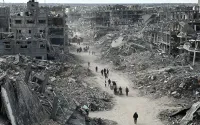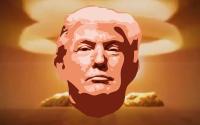Published on Wednesday, August 18, 2004 by Knight-RidderTom Lasseter
When U.S. forces pushed through southern Iraq in the war last year, Najaf was just another spot on the map to Baghdad. But during the past two weeks of fighting in Najaf, the dusty city proved to be a glaring example of the limits of American military might in post-sovereignty Iraq.
Few people doubt that U.S. military forces have the ability to overwhelm Iraqi rebels. But as was the case in Fallujah earlier this year, the need to balance force with politics has stripped away many of their advantages.
As a result, firebrand cleric Muqtada al-Sadr has grown in stature as a rebel icon.
The two military forces are starkly different.
Fighters loyal to al-Sadr, called the Mahdi Army, run the streets of Najaf in a chaotic circus of men in flip-flops and sandals who pump their old AK-47s and rocket-propelled grenade launchers in the air, call for death to America and generally shoot at anything moving.
U.S. forces are better equipped, in uniforms, boots and body armor, and they ride in armored vehicles topped with machine guns and cannons.
But while the Mahdi Army can move and shoot pretty much at will, U.S. commanders are forced into deliberate, careful maneuvers, waiting for political discussions in Washington and Baghdad to bear fruit.
U.S. forces no longer have the advantage of overwhelming air power. After cordoning off the city center's Imam Ali Shrine and surrounding areas, the Marines had to dismount and pick their way through a nearby cemetery, fighting close-quarter battles among the mausoleums and headstones with Mahdi gunmen who invited death as a passage to paradise.
The reasons were these:
There was the public relations concern of killing too many civilians in the tightly packed Najaf neighborhoods. Many of the homes are old buildings that would collapse if hit by a tank round.When al-Sadr hunkered down in the shrine, it became impossible to launch airstrikes against him without seriously damaging one of the holiest sites in Shiite Islam and risking a wider uprising.There were also profound political implications for Prime Minister Iyad Allawi, a supporter of the U.S. presence in Iraq whose political base could fracture if things went badly in Najaf.
According to figures supplied by the military, the toll from the violence has been lopsided. In one short period, fewer than 10 Marines were killed, while U.S. officials placed the number of Mahdi dead at more than 300.
But al-Sadr was able to bring in thousands of supporters, primarily from the Baghdad slum of Sadr City, who vowed to be human shields. With 3 million people in Sadr City, if only 5 percent of the population were to support him, he'd have 150,000 people behind him, more than the number of U.S. troops in Iraq.
With every photograph and television shot of a Mahdi fighter daring to fight the U.S. military, al-Sadr's support seemed to grow amongst Iraq's majority Shiite population, once counted on to be the backbone of post-war U.S. policy in Iraq.
Throughout it all, U.S. forces have been hamstrung.
Instead of being able to unload the massive air superiority at their fingertips - continuous Apache helicopter strikes and F-15 fighter jet bombing runs that could have wiped out the militia in a day - they had to pick and choose, start and stop.
In the pauses between, al-Sadr played a game of military inches. Despite the overwhelming U.S. firepower on the ground in Najaf, he looks to have gained ground.






